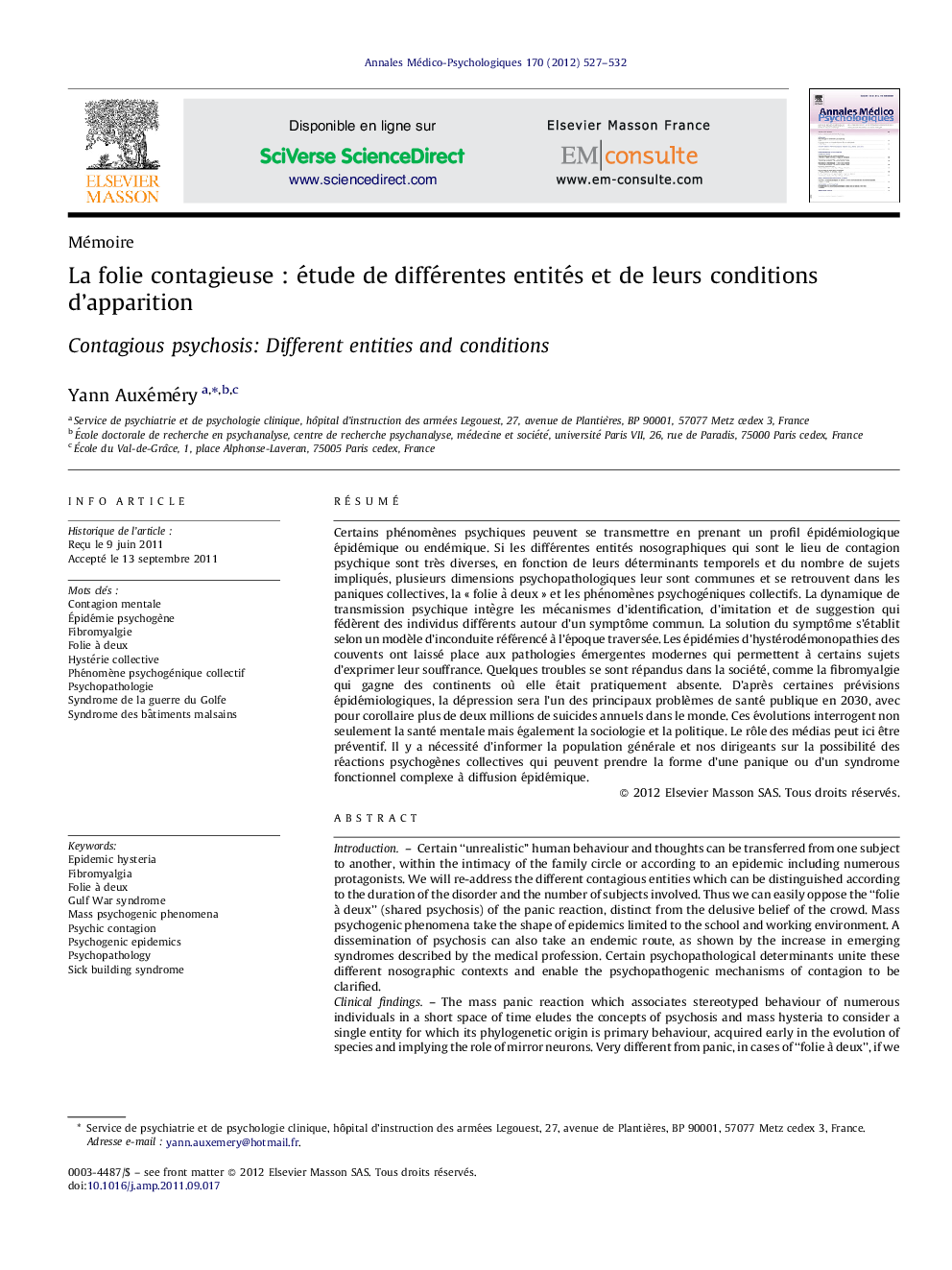| کد مقاله | کد نشریه | سال انتشار | مقاله انگلیسی | نسخه تمام متن |
|---|---|---|---|---|
| 313904 | 534551 | 2012 | 6 صفحه PDF | دانلود رایگان |

RésuméCertains phénomènes psychiques peuvent se transmettre en prenant un profil épidémiologique épidémique ou endémique. Si les différentes entités nosographiques qui sont le lieu de contagion psychique sont très diverses, en fonction de leurs déterminants temporels et du nombre de sujets impliqués, plusieurs dimensions psychopathologiques leur sont communes et se retrouvent dans les paniques collectives, la « folie à deux » et les phénomènes psychogéniques collectifs. La dynamique de transmission psychique intègre les mécanismes d’identification, d’imitation et de suggestion qui fédèrent des individus différents autour d’un symptôme commun. La solution du symptôme s’établit selon un modèle d’inconduite référencé à l’époque traversée. Les épidémies d’hystérodémonopathies des couvents ont laissé place aux pathologies émergentes modernes qui permettent à certains sujets d’exprimer leur souffrance. Quelques troubles se sont répandus dans la société, comme la fibromyalgie qui gagne des continents où elle était pratiquement absente. D’après certaines prévisions épidémiologiques, la dépression sera l’un des principaux problèmes de santé publique en 2030, avec pour corollaire plus de deux millions de suicides annuels dans le monde. Ces évolutions interrogent non seulement la santé mentale mais également la sociologie et la politique. Le rôle des médias peut ici être préventif. Il y a nécessité d’informer la population générale et nos dirigeants sur la possibilité des réactions psychogènes collectives qui peuvent prendre la forme d’une panique ou d’un syndrome fonctionnel complexe à diffusion épidémique.
IntroductionCertain “unrealistic” human behaviour and thoughts can be transferred from one subject to another, within the intimacy of the family circle or according to an epidemic including numerous protagonists. We will re-address the different contagious entities which can be distinguished according to the duration of the disorder and the number of subjects involved. Thus we can easily oppose the “folie à deux” (shared psychosis) of the panic reaction, distinct from the delusive belief of the crowd. Mass psychogenic phenomena take the shape of epidemics limited to the school and working environment. A dissemination of psychosis can also take an endemic route, as shown by the increase in emerging syndromes described by the medical profession. Certain psychopathological determinants unite these different nosographic contexts and enable the psychopathogenic mechanisms of contagion to be clarified.Clinical findingsThe mass panic reaction which associates stereotyped behaviour of numerous individuals in a short space of time eludes the concepts of psychosis and mass hysteria to consider a single entity for which its phylogenetic origin is primary behaviour, acquired early in the evolution of species and implying the role of mirror neurons. Very different from panic, in cases of “folie à deux”, if we consider the index subject as delirious, this delirium can be shared by a neurotic or a psychotic subject. The transmission mechanisms are thus different: hysterical delirium can be transmitted in the same way as cases of mass hysteria. In the course of history, epidemics of possession and hystero-demonopathy in convents have been substituted by health fears concerning the environment and potential pollution as well as infections or nuclear risk. Dispassionate communication with a dimensional approach to disorders considering mixed organic and mental contagions can be shared with “intoxicated” subjects. A proband contaminated by a toxic substance can show symptoms that spread by mimicry in other physically non-intoxicated employees. Sometimes the phenomenon is totally psychogenic and the proband has suffered no toxic reaction. Thus an authentic somatic illness can be secondarily epidemic: its propagation is psychogenic while the first organic medical entity remains. It is thus very difficult to establish a distinction between a somatic illness and the eponymous psychosomatic disorder of which the cardinal symptoms are the same, although expressed differently in the discourse.DiscussionIf the different entities that are the location of psychological contagion are very diverse according to their temporal determinants and the number of subjects involved, certain psychopathological dimensions are combined. The dynamics of transmission involve mechanisms of identification, imitation and suggestion which will federate the individuals around a symptom. The solution of psychosis sometimes varies according to a socially well-defined mode that can be described as a model of misconduct. Thus the epidemics of hystero-demonopathy in convents echo emerging pathologies of the modern era which enable certain subjects to express their suffering.ConclusionsOther disorders have spread through society such as toxicophilic behaviour or even mental anorexia which has spread to continents where it was practically absent. According to certain forecasts, depression will be a major health problem in 2030 resulting in two million suicides a year worldwide. These evolutions question not only mental health but also sociology and politics. The role of the media here can be deleterious or preventive. It is undoubtedly necessary to inform the leaders and the general population on the possibility of this type of mass reaction which can take the shape of panic or a highly contagious complex functional syndrome.
Journal: Annales Médico-psychologiques, revue psychiatrique - Volume 170, Issue 8, October 2012, Pages 527–532